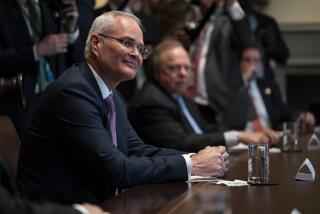Data point to steady but unspectacular economic expansion
A new round of data released Wednesday offers evidence that the economy is continuing to grow but raises questions about the strength of the industrial sector in the months ahead.
Consumer spending rose a higher-than-expected 0.7% in October, while personal income increased 0.2%, the Commerce Department said. Those numbers support the idea of a steady, if unspectacular, expansion in the economy early in the fourth quarter.
Meanwhile, the Labor Department said that 466,000 people filed first-time applications for unemployment insurance benefits last week, the lowest level since September 2008, indicating that although job losses remain high they are moderating.
In a disappointing report, orders for durable goods -- items expected to last several years -- fell unexpectedly, dropping 0.6%, mainly because of a decline in defense orders. That is a negative sign for the country’s industrial sector in the months ahead.
Taken together, the reports give some reason for optimism heading into the crucial holiday shopping season. The question now is whether the apparent economic growth can continue into 2010, and if so, whether it will do so with any momentum. The report on durable goods is not very promising on that front.
Economists are generally expecting modest sales increases at retailers this holiday season compared with last year’s depressed levels. October’s jump in spending supports that expectation.
“The news on the consumer is OK,” said Michael Feroli, an economist at JPMorgan Chase & Co. “It’s definitely not the collapsing consumer that everybody had been fearing.”
The fall in jobless claims continued a very slow decline begun in the spring. The number of claims can fluctuate significantly from week to week, but their four-week moving average -- considered a more reliable indicator -- also fell last week, to 496,500 from 513,000.
The total number of people receiving ongoing unemployment benefits dropped as well, to 5.4 million from 5.6 million.
“The numbers are definitely heading in the right direction,” said Steven Wieting, an economist with Citigroup Global Markets. “Altogether, these were relatively optimistic.”
Excluding military-related goods, orders for durable goods such as automobiles, airplanes and industrial machinery rose 0.4%, and economists cautioned against reading too much into one month’s results.
Nonetheless, the drop in overall orders suggests that the sharp rise in industrial activity late in the summer has not carried over to the fall.
There was a surge in production of goods including machinery, computers, engines, turbines and electrical equipment in July, August and September as inventories were replenished, but that has since flattened out, according to Daniel Meckstroth, chief economist for the Manufacturers Alliance/MAPI, a trade group for the manufacturing industry.
“It means that the talk of a V-shaped recovery is not real,” Meckstroth said. “You can’t expect the industrial sector to bounce back like the stock market did. It is impaired.”
Companies are simply repairing and replacing necessary equipment instead of having real growth demand, Meckstroth said.
One reason for the uneven recovery is that construction of shopping malls, office buildings and other nonresidential buildings is still falling as the commercial real estate market continues to weaken.
That is depressing orders for manufactured products that go into these buildings -- such as steel, bricks, concrete, drywall, office furniture and computers.
Irwin and Hedgpeth write for the Washington Post.






